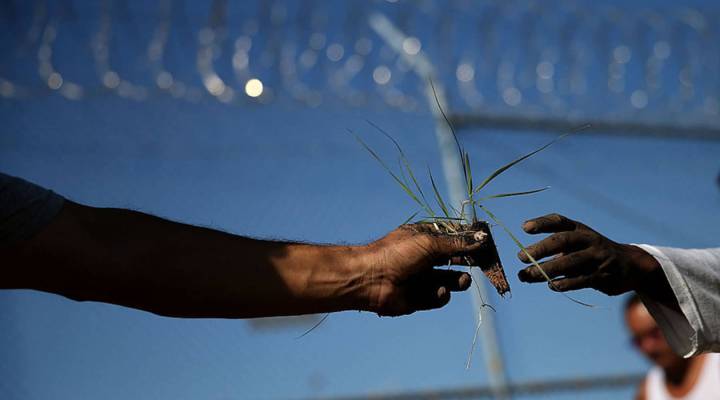
Farm-to-table comes to a Louisiana jail

The phrase farm-to-table is a big selling point in the culinary world. The food sells at a premium because of the wholesome halo around it — a direct path from the earth to your plate. But farm-to-table doesn’t have to be about luxury. One Louisiana jail is working with the concept.
About 10 miles outside of Lafayette, five inmates from the Parish jail are harvesting broccoli, turnips and cabbages that look like big, green rosebuds. Five days a week, at 6 a.m., a prison guard drives them out to the farm. Joe Olivier has been working the fields for two months. He’s not a talkative guy, but he says that he’s grown these plants from seeds.
“I talk to them sometimes,” he said. “Talk to the broccoli and the cabbage sometimes.”
“Is it easier to talk to the vegetables than to talk to people?” I ask.
“For me it is.”
Olivier is 32 and finishing up a sentence for possession of a firearm. That’s illegal because he was previously convicted of a felony. Seeing other people eat what he grows feels really good, he said. A bigger impact is how the farm has changed how he sees everything.
“I’ll be riding down the road, going back to jail, and see trees and wonder how long they’ve been there,” he said. “Makes you think. It’s all living things. Comes from nothing really.” He said it makes him consider getting a book to “find out where everything really comes from.”
The day’s harvest includes 400 pounds of cabbage — enough to feed the entire jail for one meal, and then some. The jail otherwise pays around $500 per meal for canned or frozen vegetables. Warden Catherine Fontenot said the farm’s chief purpose isn’t to save money, though. Rather, it’s a down payment on a bigger investment: rehabilitation.
“Meals and food is the basic way that we show love and respect for one another,” Fontenot said. “And that’s what we need to show with people who have offended us the greatest.”
| Montana inmates learn job and life skills while raising cattle on prison ranch |
| The cost of prison is more than just time served |
Standing in the field, Warden Fontenot said she believes better nutrition improves inmate behavior, which makes everyone safer. She says everyone at the jail — inmates and correctional staff — benefit from this food.
“It’s a small number that can work [on the farm], but it’s a greater number that’s in the kitchen that is working with the product that they produced,” she said. “And so it’s like a hand-off of good things, and when you finally eat, it’s the whole jail.”
Two or three times a week, the farm crew delivers produce to the jail, where the kitchen crew takes over. Inmate Darius Linden, who’s serving theft and domestic abuse convictions, explains how he preps the turnip greens just delivered to him. Linden has been in jail six months, and has worked in the kitchen for one month.
“Being that they’re freshly picked, you know they tend to, might have a little something — bugs or whatever,” he said as he rinses the greens thoroughly. He then chops them on a cutting board. Not only does Linden say he loves his kitchen job, he says he’s eating healthier and feeling better.
The warden said since the prison started feeding farm vegetables to inmates, the jail has spent less on medicine for hypertension and diabetes. And, she said more inmates have signed up for things like GED and anger management classes. She can’t prove those changes are entirely due to the farm, but the warden believes they’re directly connected.
Hendrick Cormier is one of the two inmate chefs. He’s 30 and serving a few years on an attempted robbery conviction. Cormier has made a mean tomato vegetable soup for the jail staff, not inmates, with broccoli from the farm.
“It’s a Louisiana dish, but my ingredients is top secret,” he said. “I grew up on this soup. When it was cold, my mom and my grandma used to make the same soup.”
There’s no cafeteria in this jail. Inmates eat in their pod — a big, open room with bunk beds in the back, tables in the front, and a wall of thick glass — after lining up at the kitchen window to get their meal.
They identify themselves by their bunk — “222 top” or “115 bottom” — and are handed a tray. The prison serves a hot breakfast and a hot dinner, but lunch is cold. A typical lunch is two pieces of white bread, turkey baloney, canned pears, a bag of chips, and a cookie.
But for dinner, there will be farm fresh steamed broccoli.
This story was reported with support from the University of California Berkeley 11th Hour Food and Farming Journalism Fellowship.
There’s a lot happening in the world. Through it all, Marketplace is here for you.
You rely on Marketplace to break down the world’s events and tell you how it affects you in a fact-based, approachable way. We rely on your financial support to keep making that possible.
Your donation today powers the independent journalism that you rely on. For just $5/month, you can help sustain Marketplace so we can keep reporting on the things that matter to you.


















